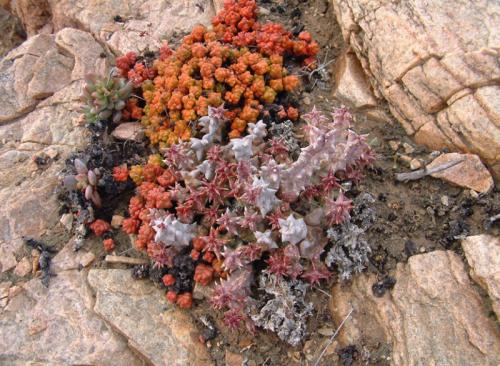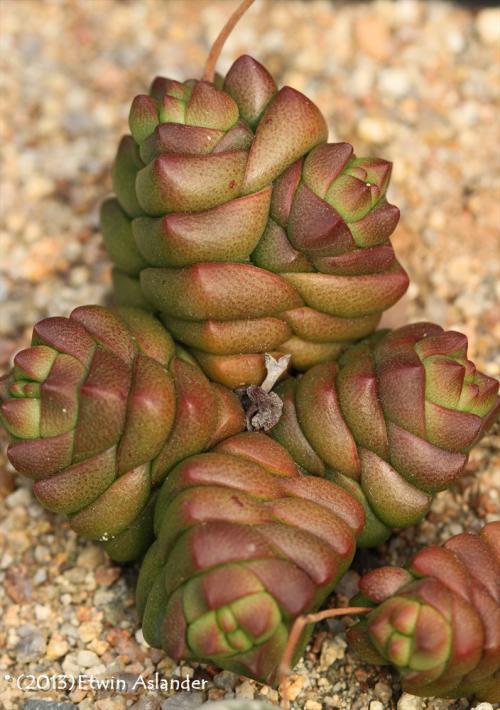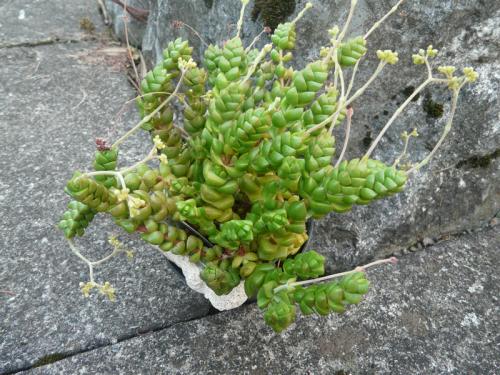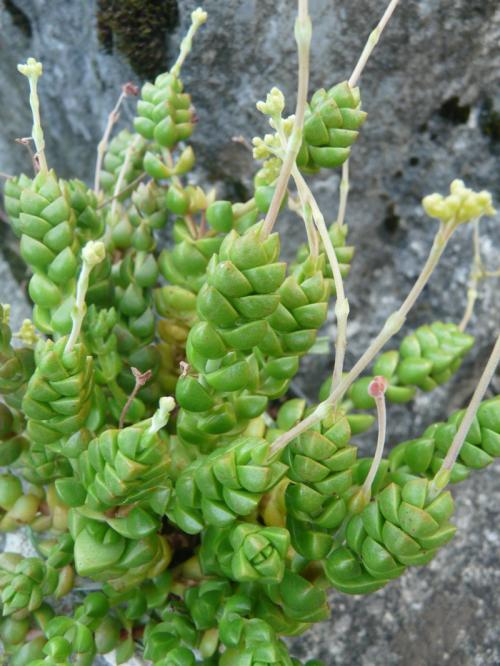MARCHANDII Friedrich, 1974 (engl./ fr.)
Synonym : Crassula otzenii hort.
Section Arta
Type : Rauh 8160, collected in the Vanrhynsdorp district without exact locality.
Rauh 8160 however is a pseudo-Rauh-number, i.e. the plant had been given to Rauh by a third party, he had not collected it himself.
Etymology : Named for G. Marchand, in charge of the Crassula collection of Julien Marnier-Lapostolle at Les Cèdres.
Distribution : Extinct at the type locality at Vanrhynsdorp. Similar plants are found at Kleinzee.
Description in Mitt. Bot. Staatssammlung München 11: 328, fig.3 (1974).
Offered as ISI 640 in 1970 as Crassula sp. nov. "Rooted cuts of UCBG 50.2093, Stellenbosch 6433, collected 7-8-46 by Mr. Otzen at Knersvlakte, Vanrhynsdorp S.A."
Notes :
1. The plant had been collected by Max Otzen (1871 - 1947), a German who came to South Africa in the 1880's. He sent it to California, among others to Paul Hutchison who named it for its collector > Crassula otzenii but never got around to describe and publish it properly.Commercial collecting was a daily occurrence at that time, so that very likely the plant was extinct at its type locality already before the middle of the 20th century.
However in California the plant was propagated and ISI could offer it in 1970 to a wider public.
It is not reported that the plant had ever been imported in Germany directly from South Africa. It is much more likely that it was Paul Hutchison who was in contact with Werner Rauh in Heidelberg who is responsible for its arrival in Germany i.e. sent a plant to Rauh (hence the pseudo-Rauh-number). Rauh, not particularly interested in crassulas passed it to the German Crassula expert Friedrich in München who, after having seen its flowers, described it in 1974, apparently ignoring that Hutchison had intended to name it for Max Otzen.
2. Tölken and Crassula marchandii :
In his thesis, A revision of the genus Crassula in southern Africa, 557, 1977, Tölken listed C. marchandii as a “species insufficiently known”. He wrote:
“A few plants, very similar to those described as C. marchandii, were collected in the Holgat River ..., but they probably represent hybrids between C. grisea (with glabrous leaves) and C. plegmatoides as both these species occur in the area.”
In Flora of Southern Africa 14: 229, 1985, he reiterated this comment, but added that they were “interpreted as hybrids ... as only single specimens were found in populations of these species.”
These comments have led some to believe that Tölken “suggested” C. grisea and C. plegmatoides as parents of C. x marchandii - see G.Rowley, Crassula, a Grower’s Guide,131, 2003 and Illustrated Handbook of Succulent Plants, 2003. However Tölken neither suggested C. marchandii as a natural hybrid nor did he suggest this parentage, he merely noted the similarity of the apparently rare hybrid found at Holgat River. For him it simply was an insufficiently known species which needed further investigation but not a hybrid.
(Moreover, Holgat River – where the similar plants had been found - and Vanrhynsdorp – where C. marchandii originally had been collected – are two fairly distant places, and neither C. grisea nor C. plegmatoides are occurring at Vanrhynsdorp.)
-----------------------------------------------------------------------------------
Section Arta
Cette espèce de Crassula fut d'abord publiée en 1974 et nommée en l'honneur de Gilles Marchand, en charge de la collection des Crassula de Julien Marnier-Lapostolle, à la villa Les Cèdres.
C. marchandii Friedrich, dans Mitt. Bot. Staatssammlung München 11 : 328, fig.3 (1974), synonyme de C. otzenii hort.
La plante type provient du Cap, district de Vanrhynsdorp.
En 1970, cette plante aux feuilles glabres d'un vert émeraude fut offerte, sous le numéro ISI 640, en tant que Crassula sp. nov. collectée par M. Otzen, à Knersvlakte, Vanrhynsdorp, (C.S.J. US 42 (2): 83,1970), plus tard nommée Crassula otzenii Hort.
Dans sa thèse, A revision of the genus Crassula in southern Africa,557, 1977, Tölken inscrivit C. marchandii comme une « espèce insuffisamment connue ». Il écrit :
« Quelques plantes, très proches de celle décrite comme C. marchandii, furent collectées près de la rivière Holgat [...], mais elles représentent probablement des hybrides entre C. grisea (à feuilles glabres) et C. plegmatoides, les deux espèces étant présentes dans la région ».
Dans Flora of Southern Africa 14: 229, 1985, il réitéra ce commentaire en ajoutant qu'elles étaient « considérées comme des hybrides [...] étant donné que des spécimens solitaires seulement furent trouvés dans les populations de ces espèces ».
Ces commentaires ont laissé penser à certains que Tölken sous-entendait C. grisea et C. plegmatoides comme parents de C. x marchandii - voir G.Rowley,Crassula, a Grower’s Guide » (p. 131) et IHSP, 2003. Cependant, Tölken n'a ni proposé C. marchandii comme un hybride naturel, ni suggéré cette parenté, il nota simplement la ressemblance avec l'hybride naturel trouvé près de la rivière Holgat. Pour lui, c'était simplement une espèce insuffisamment connue nécessitant une enquête plus poussée, mais pas un hybride.
(En outre, la rivière Holgat – où les plantes similaires ont été découvertes – et Vanrhynsdorp – où C. marchandii fut collectée – sont deux endroits bien distants, et ni C. grisea, ni C. plegmatoides ne poussent à Vanrhynsdorp.)

Photo Erhan Uludag

Photo Etwin Aslander


Photos Margrit Bischofberger